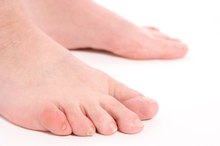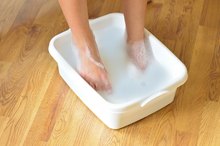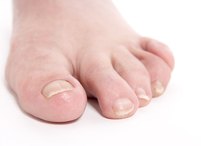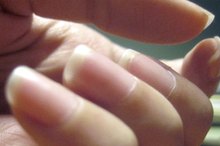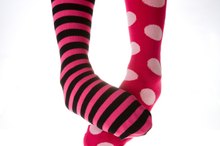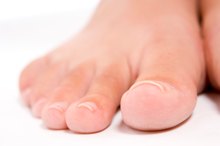Curved Toenail Problems
Ingrown, curved, deformed toenails--onychogryposis--accounts for 20 percent of patients seeking family medical attention for a foot problem 1. The curved nail punctures and digs into the skin at the sides of the nail, introducing bacterial infection and inflammation. Untreated, this condition leads to a red, swollen, painful condition often characterized by malodorous drainage.
If you are experiencing serious medical symptoms, seek emergency treatment immediately.
Appearance
The nail edges penetrate deeply into the skin along the nail’s sides. Sometimes, a small spike or corner of the nail embeds into the skin like a knife. The resultant infection causes granulation tissue (thickening skin around a healing wound) to develop.
Nail Related Causes
Ingrown Thumbnail
Learn More
The causes of ingrown toenails include trauma, such as a stubbed toe or repetitive injury caused by rubbing or kicking; poorly fitting footwear, when either socks or shoes are too small or too tight 1. Nail conditions, such as:
- fungal infections,
- the most common cause
- improper trimming
- encourages skin to fold over the nail
The tendency for ingrown toenails may be heredity or health-related 1. Another natural cause is simply aging.
Health Related Causes
Iron and zinc deficiencies or thyroid problems may cause nails to curve upward, exposing them to trauma. Nails that curve downward may indicate heart and liver problems, respiratory problems or a deficiency in Vitamin B12.
Home Care
How to Treat Lifted Toenails
Learn More
Patients may perform some treatment to relieve ingrown toenails 1. If an infection is suspected, or if the patient has high risk foot issues, such as diabetes, nerve damage or circulations problems, they should seek professional care.
It is recommended that people with this condition soak feet in room temperature water with Epsom salts, gently massaging the side of the nail to reduce inflammation. However, they should not repeatedly cut the nail, cut notches in the nail, trim nail borders or place cotton under the nail. Contrary to popular belief, these practices do not change the growth pattern of the nail and may introduce bacteria, worsening the condition.
- Patients may perform some treatment to relieve ingrown toenails 1.
- If an infection is suspected, or if the patient has high risk foot issues, such as diabetes, nerve damage or circulations problems, they should seek professional care.
Physician Care
After examination, a physician likely will prescribe an oral antibiotic for the infection and an anti-inflammatory for the inflammation. Minor in-office surgery to remove the nail’s side border eases pain and inflammation and allows the infection to heal. Some recurring ingrown nails require removal of the nail root.
Prevention
Careful care of nails prevents most ingrown nail occurrences. Proper trimming involves cutting nails in a straight line, and leaving a portion of the white tip. Make that sure shoes fit. If the toe is short or tight, it puts pressure on the toenail. Loose shoes cause the foot to push into the toe area, causing the same effect as if the shoe were too tight.
- Careful care of nails prevents most ingrown nail occurrences.
- Loose shoes cause the foot to push into the toe area, causing the same effect as if the shoe were too tight.
Serious Conditions
Clubbed toenails--where the ends of the toes are enlarged, and the nails are abnormally curved and shiny--signifies more serious medical conditions. According to the American Academy of Family Physicians, some illnesses associated with clubbing include heart and lung problems, inflammatory bowel disorders, such as Crohn’s disease or ulcerative colitis. Cirrhosis of the liver and thyroid problems also result in clubbing in some cases. Seek professional medical advice for any of these conditions.
- Clubbed toenails--where the ends of the toes are enlarged, and the nails are abnormally curved and shiny--signifies more serious medical conditions.
- According to the American Academy of Family Physicians, some illnesses associated with clubbing include heart and lung problems, inflammatory bowel disorders, such as Crohn’s disease or ulcerative colitis.
Related Articles
References
- Foot Health Facts: Ingrown toenails
- ePodiatry: Ingrown toe nail (Onychocrytosis)
- American Family Physician: Nail abnormalities
- American Family Physician: Management of the ingrown toenail
- Dąbrowski M, Litowińska A. Recurrence and satisfaction with sutured surgical treatment of an ingrown toenail. Ann Med Surg (Lond). 2020 Jun 26;56:152-160. doi: 10.1016/j.amsu.2020.06.029. PMID: 32637092; PMCID: PMC7330155.
- Haneke E. Controversies in the treatment of ingrown nails. Dermatol Res Pract. 2012;2012:783924. doi: 10.1155/2012/783924. PMID: 22675345; PMCID: PMC3362847.
- Miquelão Canuto Verussa MJ, Biselli Boarini LM, Gabbi T. "Super U" technique for ingrown nails: a tertiary hospital experience between 2011 and 2018. Int J Dermatol. 2019 Oct 24. doi: 10.1111/ijd.14694. Epub ahead of print. PMID: 31650538.
- Arica IE, Bostanci S, Kocyigit P, Arica DA. Clinical and sociodemographic characteristics of patients with ingrown nails. J Am Podiatr Med Assoc. 2019 May;109(3):201-206. doi: 10.7547/17-023. PMID: 31268783.
- Mayeaux EJ Jr, Carter C, Murphy TE. Ingrown toenail management. Am Fam Physician. 2019 Aug 1;100(3):158-164. PMID: 31361106.
- Sánchez LC, Zalacaín-Vicuña AJ. Onychoplasty with 1064-nm Laser: Matrixectomy for Treatment of Ingrown Toenails. J Am Podiatr Med Assoc. 2019 Sep;109(5):401-406. doi: 10.7547/17-008. PMID: 31599675.
- Muriel-Sánchez JM, Becerro-de-Bengoa-Vallejo R, Montaño-Jiménez P, Coheña-Jiménez M. The treatment of ingrown nail: Chemical matricectomy with phenol versus aesthetic reconstruction. A single blinded randomized clinical trial. J Clin Med. 2020 Mar 20;9(3):845. doi: 10.3390/jcm9030845. PMID: 32244966; PMCID: PMC7141528.
- American Academy of Family Physicians. Ingrown toenails. January 4, 2018.
Writer Bio
Dana Griffin has written for a number of guides, trade and travel periodicals since 1999. She has also been published in "The Branson Insider" newspaper. Griffin is a CPR/first-aid instructor trainer for the American Red Cross, owns a business and continues to write for publications. She received a Bachelor of Arts in English composition from Vanguard University.


